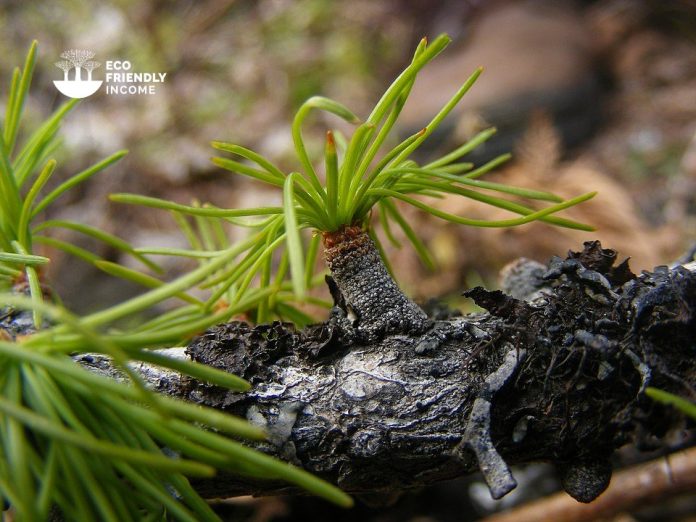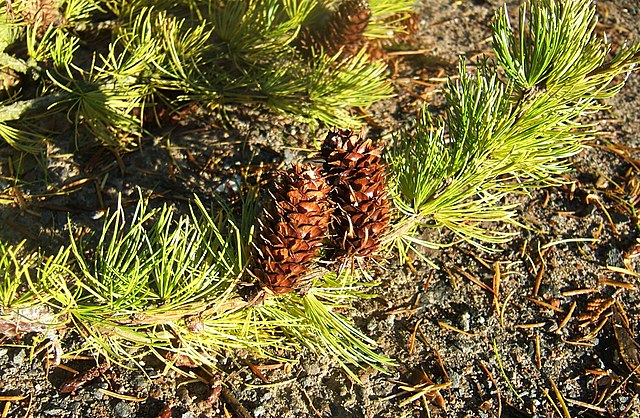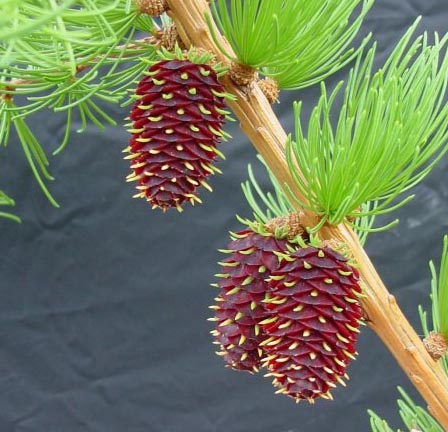
Featured Photo by Jesse Taylor / CC BY-SA 3.0
A field guide on how to identify and propagate Western Larch (Larix occidentalis), a hardy tree that is native to western North America.
How to Identify Western Larch (Larix occidentalis)
Leaves

Western larch needles are linear-shaped, with entire margins (smooth). They grow on the stems in fascicle structures that appear in alternate arrangements.
You’ll notice that the needles of the Western Hemlock tree are long and grow in bunches of 15 to 30.
These bunches are found on stubby, woody projections that stay on the twig even after the needles have fallen off.
Curious about leaf characteristics? Check out our plant identification database.
Cones

When you look at the seed cones of the Western Hemlock tree, you’ll notice that they are elongated and have a color that ranges from red to reddish-brown.
If you take a closer look, you’ll see that the scales on these cones have white hairs on their lower surface and have long, slender bracts (spikes) that stand out prominently.
The tree’s pollen cones, on the other hand, are yellow in color.
Flowering Season
Western larch cones start to grow in early summer and show beautiful colors.
They will mature in late summer and naturally open by fall.
Habitat
Western larch is native to the Rocky mountain range.
You’ll often see Western Larch growing in mixed forests, but it’s possible to find it growing in a group of trees by itself after a major wildfire.
Western Larch is limited in where it can grow because it’s sensitive to low temperatures and can be damaged by frost. This is because it continues to grow from spring all the way until September, while most evergreen conifers stop growing by mid-July.
Some other understory plants that associate with western larch are:
- Beargrass (Xerophyllum tenax)
- Huckleberry (Vaccinium spp.)
- Thimbleberry (Rubus parviflorus)
- Menziesia (Menziesia ferruginea)
- Ninebark (Physocarpus malvaceus)
- Serviceberry (Amelanchier spp.)
- Bearberry (Arctostaphylos uva-ursi)
Wildlife Value
Rodents enjoy eating the seeds and seedlings, while birds search for insects and even use the tree as a place to nest. Squirrels are known to cut and store cones.
Western larch trees are important for the pileated woodpecker, who loves to browse the tree for food.
Large mammals like deer, elk, and moose also consume the tree, although they only do so as a last resort.
Lastly, black bears have been known to feed on the concentrated sugars found in the sap layer during the spring.
How to Propagate Western Larch (Larix occidentalis)

Hardiness Zone: 4-8

Soil Type: Loam, sand.

Water: Normal to High.

Exposure: Full Sun
You can propagate western larch with these two methods:
- Stem Cuttings: It provides established trees faster, but is tricky, and will probably have a lower success rate.
- By Seed: The success rate is high but takes longer to get established saplings.
In my experience, conifers are not easy to root, as compared to leafy plants. Seeds have worked great for me, for that reason, this will be the focus.
If you wish to learn more on the stem cutting technique, check out our propagation guide.
How to Propagate Western Larch (Larix occidentalis) by Seed
Sowing seeds is the preferred method for propagating Siberian larch. If you have access to trees nearby, you can gather the seeds yourself.
If not, ordering seeds online is an option.
To harvest the seeds, simply gather the cones and use the correct method to extract the seeds from inside.
How to Harvest Seeds
The cones containing the seeds mature and become ready for picking during late summer to fall.
If you pick the cones at this time, you’ll need to stratify them. However, it’s best to wait until mid to late winter to pick the cones, as nature will have done the stratification process for you.
To harvest the seeds, simply place the cones in a brown bag to dry and let them naturally open. Then, knock the seeds out of the cones.
If you prefer to harvest the cones while they’re easily accessible during warm weather, you can stratify them at home by following a specific process.
Stratification & Sowing
To stratify western larch seeds using the cold method, follow these steps:
- Mix the seeds with moist sand or peat moss and put them in a labeled plastic bag, including the date.
- Place the bag in the freezer for 21 days, then remove it.
- Soak the seeds in warm water for 24 hours to soften their outer layer.
- Keep the seeds in the refrigerator for another 7 days, making sure the sand or peat moss stays moist.
- After the stratification period, plant the seeds in a soil mix of peat moss and sand that drains well, and keep them moist until they germinate.
Recommended soil mix: Peat moss & sand.
Your larch seeds should germinate within a week.
Note: They will still germinate without cold treatment, so you can skip it all together. Although cold stratification will increase seed germination rate considerably.
FAQ
Q: What is special about larch?
A: Larch are the only conifers that lose their needles every year. During this process in autumn, the needles turn into a golden yellow color that’s quite a sight to see.
Q: Is western larch the same as tamarack?
A: Not necessarily, tamarack larch is the name most often given to the eastern species Larix laricina.
Q: How big does a western larch get?
A: You can expect a Western larch tree to grow up to 80 meters in height and have a diameter of 1.5 meters when fully mature.
Q: Do larch trees have deep roots?
A: As a Western larch tree grows, it develops a strong and extensive root system. The roots of young larch trees can extend as deep as 100 cm below the surface. However, mature larch trees that have fallen over due to wind are often affected by root rot.
